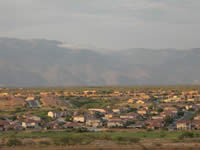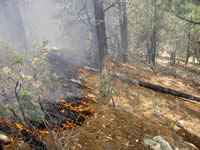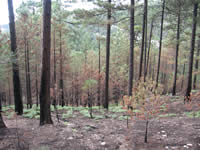Forests and Rangelands Success Story
Returning Natural Fire to the Rincon Mountains
Saguaro National Park, Arizona
National Fire Plan - Fuels Reduction
2008

View of Chimenea Wildland Fire Use from Vail, Arizona. NPS photo by Perry Grissom

Fire reduces pine needles on the forest floor.

Ferns and grasses were observed growing in the burned area two months after the fire. NPS photo by Perry Grissom
The 130-acre Chimenea Wildland Fire Use was ignited by lightning on June 26, 2008. Located in the remote Saguaro Wilderness in the Rincon Mountains, the fire was within an area pre-approved for wildland fire use in the park’s fire management plan.
Fire managers actively monitored the fire from the ground and by air until it received more than three inches of rain in early July. Pockets of heavy dead and down fuels in the interior of the burn continued to smolder until the area received additional rainfall. The fire was declared out in late July. Fire managers and resource management staff worked together throughout the fire to monitor fire activity in sensitive natural resource areas and were prepared to use a full range of actions to delay, direct, or minimize the spread of fire if needed.
By monitoring this fire and calling in resources as needed, fire managers were able to free up limited firefighting resources to respond to higher priority fires nationally. Limiting the need for firefighters to work in remote, rugged terrain during lightning season increased safety. Limiting the need for helicopter support to shuttle crews, equipment, and supplies also helped reduce costs and preserve wilderness values.
This fire occurred in a fire-adapted ecosystem. Frequent, low to moderate intensity fires recycle nutrients back into the soil. Fires also reduce pine needles, leaves, grass, downed logs, seedling trees, and shrubs on the forest floor. Large trees usually survive. In places, fire can move into the canopy, killing trees, which are rapidly replaced by new plant growth that thrives on light. A variety of fires on the landscape over time results in a shifting mosaic of vegetation that creates diverse wildlife habitat.
Most fires in the park are lightning-caused and occur during June through August with the onset of the monsoon. Storms typically bring dry lightning, followed by significant precipitation within a few weeks. Saguaro National Park was one of the first national parks in the country to manage natural ignitions.
Contact: Kristy Lund, Fire Management Officer, (520) 733-5130.